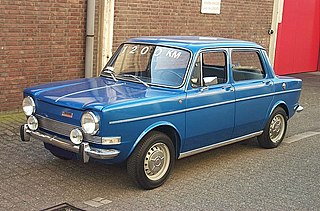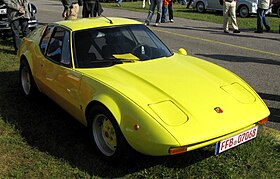
Abarth & C. S.p.A. is an Italian racing- and road-car maker and performance division founded by Italo-Austrian Carlo Abarth in 1949. Abarth & C. S.p.A. is owned by Stellantis through its Italian subsidiary. Its logo is a shield with a stylized scorpion on a yellow and red background.

The Fiat X1/9 is an Italian two-seater mid-engined sports car designed by Bertone and manufactured by Fiat from 1972–1982 and subsequently by Gruppo Bertone from 1982–1989.

The Fiat 124 is a small family car manufactured and marketed by Italian company Fiat between 1966 and 1974. The saloon superseded the Fiat 1300 and spawned station wagon, four-seater coupé, and two-seater convertible variants.

The Fiat 500 is an economy / city car that was manufactured and marketed by Fiat Automobiles from 1957 until 1975. It was sold as a two-door semi-convertible or saloon car and as a three-door panel van or estate car.

The Fiat 131 is a mid-size family car manufactured and marketed by Fiat from 1974 to 1984 after its debut at the 1974 Turin Motor Show. Available as a two-door and four-door saloon and 5-door estate across a single generation, the 131 succeeded the Fiat 124.

The Fiat Seicento is a city car produced by the Italian company Fiat, introduced at the end of 1997 as a replacement for the Fiat Cinquecento, although it was also based on the Cinquecento. The Seicento did not differ much from its predecessor, retaining the same engines, chassis and general dimensions, although it did gain a minor 90 mm in length.

The Fiat 600 is a small, rear-engined city car and economy family car made by Italian carmaker Fiat from 1955 to 1969 — offered in two-door fastback sedan and four-door Multipla mini MPV body styles. The 600 is considered a pop icon of the Italian economic miracle, and the three-row seating Multipla, though diminutive and odd-looking, is seen as one the first mass-produced minivans.

The Lancia Montecarlo is a Pininfarina-designed two-seater, mid-engined sports car manufactured and marketed by Lancia in Italy for model years 1975-1981, across two series.

The Fiat 124 Sport Coupé is a two-door, four-seater notchback coupé produced by the Italian automaker Fiat in three generations between 1967 and 1975. It was based on the Fiat 124 saloon.

The Fiat 124 Sport Spider is a convertible sports car marketed by Fiat for model years 1966–1985. Designed by and manufactured at the Italian carrozzeria Pininfarina factory, the monocoque, front-engined, rear-drive Sport Spider debuted at the November 1966 Turin Auto Show with styling by Tom Tjaarda.

The Autobianchi A112 is a supermini produced by the Italian automaker Autobianchi. It was developed using a shrunken version of the contemporary Fiat 128's platform. The mechanicals of the A112 subsequently underpinned the Fiat 127. It was introduced in November 1969, as a replacement for the Bianchina and Primula, and was built until 1986, when it made way for the more modern Autobianchi Y10. Over 1.2 million A112s were produced in Autobianchi's Milan factory.

The Fiat 850 is a small rear-engine, rear-wheel-drive car manufactured and marketed by Italian car manufacturer Fiat from 1964 to 1973.

The Fiat 2300 is a six-cylinder executive car which was produced by Italian automotive manufacturer Fiat between 1961 and 1968. The 2300 was made as saloon, estate car and coupé. The 2300 saloon is noteworthy as in 1966 it became the first Fiat model to be available with an automatic transmission.

The Simca 1000, or Simca Mille in French, is a small, boxy rear-engined four-door saloon, manufactured for 18 years by French automaker Simca, from 1961 to 1978.

The Fiat 1800 and 2100 are six-cylinder automobiles produced by Italian manufacturer Fiat between 1959 and 1968. Both models were introduced in 1959. A four-cylinder 1500-cc version, the 1500L, was added to the range in 1963, when the 2100 was replaced by the larger engined 2300. The 1800/2100 were designed by Fiat's own Dante Giacosa.

The Fiat-Abarth 750 is a compact sporting series of automobiles manufactured by the Italian manufacturing firm Abarth & C. of Turin, Italy in the 1950s and 1960s. The cars used the floorpan and often the bodywork of the Fiat 600 but were fitted with Abarth's modified engines. Abarth also offered a number of bodyworks by other designers for the 750 and its derivatives, most famously Zagato but also Allemano and others.
Giannini Automobili S.p.A. is an Italian tuning company and a former producer of cars. Their focus has mainly been on Fiat cars. It was founded in 1920 by brothers Attilio and Domenico Giannini. The company headquarters are in Rome, Italy.

The Carrozzeria Francis Lombardi was founded in 1947 in Vercelli, Italy, by noted pilot Carlo "Francis" Lombardi. They originally engaged in some aeronautical design, but this soon ended. Their most famous car was the Lombardi Grand Prix, which was also marketed under a variety of other names such as O.T.A.S. and Abarth. The company was closed in 1973.

Abarth Simca GT refers to a number of sports cars produced by Italian manufacturer Abarth between 1962 and 1965.
The Fiat Abarth OTR 1000, alternatively known as Fiat Abarth 1000 OTR, is a sport subcompact model automobile produced by the Italian automobile manufacturer Abarth. With its special "Radiale" engine, it was built between 1964 and 1969 in various versions in very small numbers based on the Fiat 850.
























